金融市场与机构(11)
- 格式:docx
- 大小:17.70 KB
- 文档页数:8

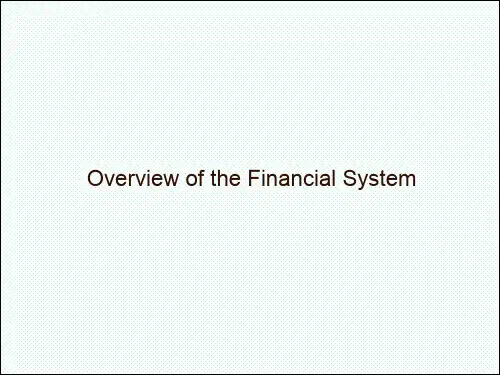
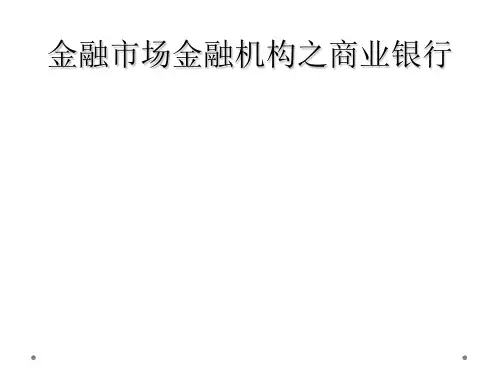

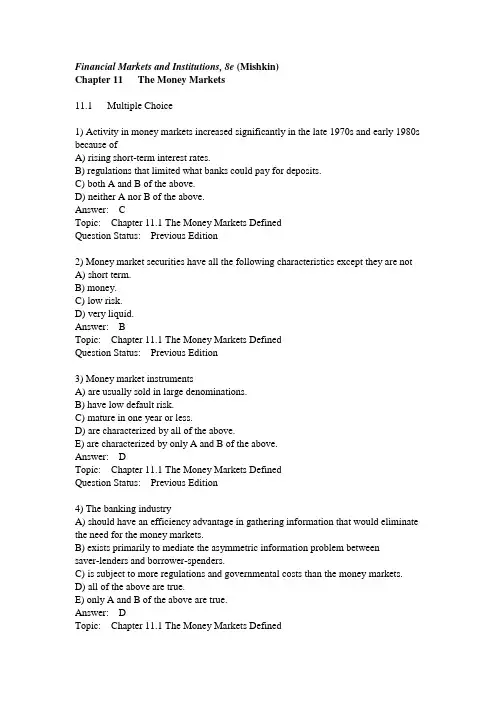
Financial Markets and Institutions, 8e (Mishkin)Chapter 11 The Money Markets11.1 Multiple Choice1) Activity in money markets increased significantly in the late 1970s and early 1980s because ofA) rising short-term interest rates.B) regulations that limited what banks could pay for deposits.C) both A and B of the above.D) neither A nor B of the above.Answer: CTopic: Chapter 11.1 The Money Markets DefinedQuestion Status: Previous Edition2) Money market securities have all the following characteristics except they are notA) short term.B) money.C) low risk.D) very liquid.Answer: BTopic: Chapter 11.1 The Money Markets DefinedQuestion Status: Previous Edition3) Money market instrumentsA) are usually sold in large denominations.B) have low default risk.C) mature in one year or less.D) are characterized by all of the above.E) are characterized by only A and B of the above.Answer: DTopic: Chapter 11.1 The Money Markets DefinedQuestion Status: Previous Edition4) The banking industryA) should have an efficiency advantage in gathering information that would eliminate the need for the money markets.B) exists primarily to mediate the asymmetric information problem betweensaver-lenders and borrower-spenders.C) is subject to more regulations and governmental costs than the money markets.D) all of the above are true.E) only A and B of the above are true.Answer: DTopic: Chapter 11.1 The Money Markets DefinedQuestion Status: Previous Edition5) In situations where asymmetric information problems are not severe,A) the money markets have a distinct cost advantage over banks in providing short-term funds.B) the money markets have a distinct cost advantage over banks in providinglong-term funds.C) banks have a distinct cost advantage over the money markets in providing short-term funds.D) the money markets cannot allocate short-term funds as efficiently as banks can. Answer: ATopic: Chapter 11.1 The Money Markets DefinedQuestion Status: Previous Edition6) Brokerage firms that offered money market security accounts in the 1970s had a cost advantage over banks in attracting funds because the brokerage firmsA) were not subject to deposit reserve requirements.B) were not subject to the deposit interest rate ceilings.C) were not limited in how much they could borrow from depositors.D) had the advantage of all the above.E) had the advantage of only A and B of the above.Answer: ETopic: Chapter 11.1 The Money Markets DefinedQuestion Status: Previous Edition7) Which of the following statements about the money markets are true?A) Not all commercial banks deal for their customers in the secondary market.B) Money markets are used extensively by businesses both to warehouse surplus funds and to raise short-term funds.C) The single most influential participant in the U.S. money market is the U.S. Treasury Department.D) All of the above are true.E) Only A and B of the above are true.Answer: ETopic: Chapter 11.3 Who Participates in the Money Markets?Question Status: Previous Edition8) Which of the following statements about the money markets are true?A) Most money market securities do not pay interest. Instead, the investor pays less for the security than it will be worth when it matures.B) Pension funds invest a portion of their assets in the money market to have sufficient liquidity to meet their obligations.C) Unlike most participants in the money market, the U.S. Treasury Department is always a demander of money market funds and never a supplier.D) All of the above are true.E) Only A and B of the above are true.Answer: DTopic: Chapter 11.3 Who Participates in the Money Markets? Question Status: Previous Edition9) Which of the following are true statements about participants in the money markets?A) Large banks participate in the money markets by selling large negotiable CDs.B) The U.S. government and corporations borrow in the money markets because cash inflows and outflows are rarely synchronized.C) The Federal Reserve is the single most influential participant in the U.S. money market.D) All of the above are true.E) Only A and B of the above are true.Answer: DTopic: Chapter 11.3 Who Participates in the Money Markets?Question Status: Previous Edition10) The most influential participant(s) in the U.S. money marketA) is the Federal Reserve.B) is the U.S. Treasury Department.C) are the large money center banks.D) are the investment banks that underwrite securities.Answer: ATopic: Chapter 11.3 Who Participates in the Money Markets?Question Status: Previous Edition11) The Fed is an active participant in money markets mainly because of its responsibility toA) lower borrowing costs to encourage capital investment.B) control the money supply.C) increase the interest income of retirees holding money market instruments.D) assist the Securities and Exchange Commission in regulating the behavior of other money market participants.Answer: BTopic: Chapter 11.3 Who Participates in the Money Markets?Question Status: Previous Edition12) Commercial banks are large holders of ________ and are the major issuer of________.A) negotiable certificates of deposit; U.S. government securitiesB) U.S. government securities; negotiable certificates of depositC) commercial paper; EurodollarsD) Eurodollars; commercial paperAnswer: BTopic: Chapter 11.3 Who Participates in the Money Markets?Question Status: Previous Edition13) The primary function of large diversified brokerage firms in the money market is toA) sell money market securities to the Federal Reserve for its open market operations.B) make a market for money market securities by maintaining an inventory from which to buy or sell.C) buy money market securities from corporations that need liquidity.D) buy T-bills from the U.S. Treasury Department.Answer: BTopic: Chapter 11.3 Who Participates in the Money Markets?Question Status: Previous Edition14) Finance companies raise funds in the money market by sellingA) commercial paper.B) federal funds.C) negotiable certificates of deposit.D) Eurodollars.Answer: ATopic: Chapter 11.3 Who Participates in the Money Markets?Question Status: Previous Edition15) Finance companies play a unique role in money markets byA) giving consumers indirect access to money markets.B) combining consumers' investments to purchase money market securities on their behalf.C) borrowing in capital markets to finance purchases of money market securities.D) assisting the government in its sales of U.S. Treasury securities.Answer: ATopic: Chapter 11.3 Who Participates in the Money Markets?Question Status: Previous Edition16) When inflation rose in the late 1970s,A) consumers moved money out of money market mutual funds because their returns did not keep pace with inflation.B) banks solidified their advantage over money markets by offering higher deposit rates.C) brokerage houses introduced highly popular money market mutual funds, which drew significant amounts of money out of bank deposits.D) consumers were unable to take advantage of higher rates in money markets because of the requirement of large transaction sizes.Answer: CTopic: Chapter 11.3 Who Participates in the Money Markets?Question Status: Previous Edition17) Which of the following is the largest borrower in the money markets?A) Commercial banksB) Large corporationsC) The U.S. TreasuryD) U.S. firms engaged in foreign tradeAnswer: CTopic: Chapter 11.3 Who Participates in the Money Markets?Question Status: Previous Edition18) Money market instruments issued by the U.S. Treasury are calledA) Treasury bills.B) Treasury notes.C) Treasury bonds.D) Treasury strips.Answer: ATopic: Chapter 11.4 Money Market InstrumentsQuestion Status: Previous Edition19) Which of the following statements are true of Treasury bills?A) The market for Treasury bills is extremely deep and liquid.B) Occasionally, investors find that earnings on T-bills do not compensate them for changes in purchasing power due to inflation.C) By volume, most Treasury bills are sold to individuals who submit noncompetitive bids.D) All of the above are true.E) Only A and B of the above are true.Answer: ETopic: Chapter 11.4 Money Market InstrumentsQuestion Status: Previous Edition20) Suppose that you purchase a 91-day Treasury bill for $9,850 that is worth $10,000 when it matures. The security's annualized yield if held to maturity is aboutA) 4 percent.B) 5 percent.C) 6 percent.D) 7 percent.Answer: CTopic: Chapter 11.4 Money Market InstrumentsQuestion Status: Previous Edition21) Suppose that you purchase a 182-day Treasury bill for $9,850 that is worth $10,000 when it matures. The security's annualized yield if held to maturity is aboutA) 1.5%.B) 2%.C) 3%.D) 6%.Answer: CTopic: Chapter 11.4 Money Market InstrumentsQuestion Status: Previous Edition22) Treasury bills do notA) pay interest.B) have a maturity date.C) have a face amount.D) have an active secondary market.Answer: ATopic: Chapter 11.4 Money Market InstrumentsQuestion Status: Previous Edition23) If your competitive bid for a Treasury bill is successful, then you willA) certainly pay less than if you had submitted a noncompetitive bid.B) probably pay more than if you had submitted a noncompetitive bid.C) pay the average of prices offered in other successful competitive bids.D) pay the same as other successful competitive bidders.Answer: BTopic: Chapter 11.4 Money Market InstrumentsQuestion Status: Previous Edition24) If your noncompetitive bid for a Treasury bill is successful, then you willA) certainly pay less than if you had submitted a competitive bid.B) certainly pay more than if you had submitted a competitive bid.C) pay the average of prices offered in other noncompetitive bids.D) pay the same as other successful noncompetitive bidders.Answer: DTopic: Chapter 11.4 Money Market InstrumentsQuestion Status: Previous Edition25) Federal fundsA) are short-term funds transferred between financial institutions, usually for a period of one day.B) actually have nothing to do with the federal government.C) provide banks with an immediate infusion of reserves.D) are all of the above.E) are only A and B of the above.Answer: DTopic: Chapter 11.4 Money Market InstrumentsQuestion Status: Previous Edition26) Federal funds areA) usually overnight investments.B) borrowed by banks that have a deficit of reserves.C) lent by banks that have an excess of reserves.D) all of the above.E) only A and B of the above.Answer: DTopic: Chapter 11.4 Money Market InstrumentsQuestion Status: Previous Edition27) The Fed can influence the federal funds interest rate by adjusting the level of reserves available to banks. The Fed canA) lower the federal funds interest rate by adding reserves.B) raise the federal funds interest rate by removing reserves.C) remove reserves by selling securities.D) do all of the above.E) do only A and B of the above.Answer: DTopic: Chapter 11.4 Money Market InstrumentsQuestion Status: Previous Edition28) The Federal Reserve can influence the federal funds interest rate by buying securities, which ________ reserves, thereby ________ the federal funds rate.A) adds; raisingB) removes; loweringC) adds; loweringD) removes; raisingAnswer: CTopic: Chapter 11.4 Money Market InstrumentsQuestion Status: Previous Edition29) The Fed can lower the federal funds interest rate by ________ securities, thereby ________ reserves.A) selling; addingB) selling; loweringC) buying; addingD) buying; loweringAnswer: CTopic: Chapter 11.4 Money Market InstrumentsQuestion Status: Previous Edition30) If the Fed wants to lower the federal funds interest rate, it will ________ the banking system by ________ securities.A) add reserves to; sellingB) add reserves to; buyingC) remove reserves from; sellingD) remove reserves from; buyingAnswer: BTopic: Chapter 11.4 Money Market InstrumentsQuestion Status: Previous Edition31) If the Fed wants to raise the federal funds interest rate, it will ________ securities to ________ the banking system.A) sell; add reserves toB) sell; remove reserves fromC) buy; add reserves toD) buy; remove reserves fromAnswer: BTopic: Chapter 11.4 Money Market InstrumentsQuestion Status: Previous Edition32) Government securities dealers frequently engage in repos toA) manage liquidity.B) take advantage of anticipated changes in interest rates.C) lend or borrow for a day or two with what is essentially a collateralized loan.D) do all of the above.E) do only A and B of the above.Answer: DTopic: Chapter 11.4 Money Market InstrumentsQuestion Status: Previous Edition33) Repos areA) usually low-risk loans.B) usually collateralized with Treasury securities.C) low interest rate loans.D) all of the above.E) only A and B of the above.Answer: DTopic: Chapter 11.4 Money Market InstrumentsQuestion Status: Previous Edition34) A negotiable certificate of depositA) is a term security because it has a specified maturity date.B) is a bearer instrument, meaning whoever holds the certificate at maturity receives the principal and interest.C) can be bought and sold until maturity.D) all of the above.E) only A and B of the above.Answer: DTopic: Chapter 11.4 Money Market InstrumentsQuestion Status: Previous Edition35) Negotiable certificates of depositA) are bearer instruments because their holders earn the interest and principal at maturity.B) typically have a maturity of one to four months.C) are usually denominated at $100,000.D) are all of the above.E) are only A and B of the above.Answer: ETopic: Chapter 11.4 Money Market InstrumentsQuestion Status: Previous Edition36) Commercial paper securitiesA) are issued only by the largest and most creditworthy corporations, as they are unsecured.B) carry an interest rate that varies according to the firm's level of risk.C) never have a term to maturity that exceeds 270 days.D) all of the above.E) only A and B of the above.Answer: DTopic: Chapter 11.4 Money Market InstrumentsQuestion Status: Previous Edition37) Unlike most money market securities, commercial paperA) is not generally traded in a secondary market.B) usually has a term to maturity that is longer than a year.C) is not popular with most money market investors because of the high default risk.D) all of the above.E) only A and B of the above.Answer: ATopic: Chapter 11.4 Money Market InstrumentsQuestion Status: Previous Edition38) A banker's acceptance isA) used to finance goods that have not yet been transferred from the seller to the buyer.B) an order to pay a specified amount of money to the bearer on a given date.C) a relatively new money market security that arose in the 1960s as international trade expanded.D) all of the above.E) only A and B of the above.Answer: ETopic: Chapter 11.4 Money Market InstrumentsQuestion Status: Previous Edition39) Banker's acceptancesA) can be bought and sold until they mature.B) are issued only by large money center banks.C) carry low interest rates because of the very low default risk.D) are all of the above.E) are only A and B of the above.Answer: DTopic: Chapter 11.4 Money Market InstrumentsQuestion Status: Previous Edition40) EurodollarsA) are time deposits with fixed maturities and are, therefore, somewhat illiquid.B) may offer the borrower a lower interest rate than can be received in the domestic market.C) are limited to London banks.D) are all of the above.E) are only A and B of the above.Answer: ETopic: Chapter 11.4 Money Market InstrumentsQuestion Status: Previous Edition41) Which of the following statements about money market securities are true?A) The interest rates on all money market instruments move very closely together over time.B) The secondary market for Treasury bills is extensive and well developed.C) There is no well-developed secondary market for commercial paper.D) All of the above are true.E) Only A and B of the above are true.Answer: DTopic: Chapter 11.4 Money Market InstrumentsQuestion Status: Previous Edition42) Money market transactionsA) do not take place in any one particular location or building.B) are usually arranged purchases and sales between participants over the phone by traders and completed electronically.C) are both A and B of the above.D) are none the the above.Answer: CTopic: Chapter 11.4 Money Market InstrumentsQuestion Status: Previous Edition43) Two important characteristics of any financial market are flexibility andA) risk.B) innovation.C) tolerance.D) capital.Answer: BTopic: Chapter 11.4 Money Market InstrumentsQuestion Status: Previous Edition44) The main role of investment companies in the money market is toA) trade on behalf of commercial accounts.B) mediate the symmetric information problem between server-lender and borrower-spenders.C) both A and B of the above.D) neither A nor B of the above.Answer: ATopic: Chapter 11.4 Money Market InstrumentsQuestion Status: Previous Edition45) In a direct placementA) the issuer bypasses the dealer and sells indirectly to the end investor.B) the dealer sells directly to the end investor.C) the issuer bypasses the dealer and sells directly to the end investor.D) none of the above.Answer: ATopic: Chapter 11.4 Money Market InstrumentsQuestion Status: Previous Edition46) The advantage of mutual funds is that theyA) require no cash up front.B) give investors with relatively small amounts of cash to invest access tolarge-denomination securities.C) always yield the highest returns.D) both A and B of the above.Answer: BTopic: Chapter 11.4 Money Market InstrumentsQuestion Status: Previous Edition47) Asset-backed commercial paper differs from conventional commercial paper in thatA) it is backed (secured) by some bundle of assets.B) its maturity usually extends well beyond 1 year.C) both A and B of the above.D) neither A nor B of the above.Answer: ATopic: Chapter 11.4 Money Market InstrumentsQuestion Status: New Question48) The usual maturity range for commercial paper is ________.A) 1 to 270 daysB) 1 to 15 daysC) 4, 13, and 26 weeksD) 1 to 7 daysAnswer: ATopic: Chapter 11.5 Comparing Money Market SecuritiesQuestion Status: New Question49) The usual maturity range for fed funds is ________.A) 1 to 270 daysB) 1 to 15 daysC) 4, 13, and 26 weeksD) 1 to 7 daysAnswer: DTopic: Chapter 11.5 Comparing Money Market SecuritiesQuestion Status: New Question11.2 True/False1) Money market securities are short-term instruments with an original maturity of less than one year.Answer: TRUETopic: Chapter 11.1 The Money Markets DefinedQuestion Status: Previous Edition2) Money market securities include Treasury bills, commercial paper, federal funds, repurchase agreements, negotiable certificates of deposit, banker's acceptances, and Eurodollars.Answer: TRUETopic: Chapter 11.4 Money Market InstrumentsQuestion Status: Previous Edition3) The term money market is actually a misnomer, because liquid securities are traded in these markets rather than money.Answer: TRUETopic: Chapter 11.1 The Money Markets DefinedQuestion Status: Previous Edition4) Money markets are referred to as retail markets because small individual investors are the primary buyers of money market securities.Answer: FALSETopic: Chapter 11.1 The Money Markets DefinedQuestion Status: Previous Edition5) The U.S. Treasury Department is the single most influential participant in the U.S. money market.Answer: FALSETopic: Chapter 11.3 Who Participates in the Money Markets?Question Status: Previous Edition6) The U.S. Treasury Department is the single largest borrower in the U.S. money market.Answer: TRUETopic: Chapter 11.3 Who Participates in the Money Markets?Question Status: Previous Edition7) Banks are unusual participants in the money market because they buy, but do not sell, money market instruments.Answer: FALSETopic: Chapter 11.3 Who Participates in the Money Markets?Question Status: Previous Edition8) Money markets are used extensively by businesses both to warehouse surplus funds and to raise short-term funds.Answer: TRUETopic: Chapter 11.3 Who Participates in the Money Markets?Question Status: Previous Edition9) The market for U.S. Treasury bills is a shallow market because so few individual investors buy T-bills.Answer: FALSETopic: Chapter 11.4 Money Market InstrumentsQuestion Status: Previous Edition10) The T-bill is not an investment to be used for anything but temporary storage of excess funds because it barely keeps up with inflation.Topic: Chapter 11.4 Money Market InstrumentsQuestion Status: Previous Edition11) The main purpose of federal funds is to provide banks with an immediate infusion of reserves should they be short.Answer: TRUETopic: Chapter 11.2 The Purpose of the Money MarketsQuestion Status: Previous Edition12) The Fed can influence the federal funds rate by adjusting the level of reserves in the banking system.Answer: TRUETopic: Chapter 11.4 Money Market InstrumentsQuestion Status: Previous Edition13) Commercial paper securities are unsecured promissory notes, issued by corporations, that mature in no more than 270 days.Answer: TRUETopic: Chapter 11.4 Money Market InstrumentsQuestion Status: Previous Edition14) A banker's acceptance is an order to pay a specified amount of money to the bearer on a given date. Banker's acceptances have been used since the twelfth century. Answer: TRUETopic: Chapter 11.4 Money Market InstrumentsQuestion Status: Previous Edition15) Interest rates on banker's acceptances are low because the risk of default is very low.Answer: TRUETopic: Chapter 11.4 Money Market InstrumentsQuestion Status: Previous Edition16) The size of the asset-backed commercial paper market nearly doubled between 2004 and 2007 to about $1 trillion.Answer: TRUETopic: Chapter 11.4 Money Market Instruments17) In general, money market instruments are low-risk, high-yield securities. Answer: FALSETopic: Chapter 11.4 Money Market InstrumentsQuestion Status: Previous Edition18) Commercial paper has been used in various forms since the 1930s.Topic: Chapter 11.4 Money Market InstrumentsQuestion Status: Previous Edition19) The Treasury accepts noncompetitive bids in ascending order of yield until the accepted bids reach the offering amount.Answer: FALSETopic: Chapter 11.4 Money Market InstrumentsQuestion Status: Previous Edition20) Not all commercial banks deal in the secondary money market for their customers.Answer: TRUETopic: Chapter 11.3 Who Participates in the Money Markets?Question Status: Previous Edition11.3 Essay1) Explain why banks, which would seem to have a comparative advantage in gathering information, have not eliminated the need for the money markets. Topic: Chapter 11.1 The Money Markets DefinedQuestion Status: Previous Edition2) Explain how the Federal Reserve can influence the federal funds interest rate. Topic: Chapter 11.1 The Money Markets DefinedQuestion Status: Previous Edition3) Explain why the money markets are referred to as wholesale markets.Topic: Chapter 11.1 The Money Markets DefinedQuestion Status: Previous Edition4) Explain why money market interest rates move so closely together over time. Topic: Chapter 11.5 Comparing Money Market SecuritiesQuestion Status: Previous Edition5) How are Treasury bills sold? How do competitive and noncompetitive bids differ? Topic: Chapter 11.4 Money Market InstrumentsQuestion Status: Previous Edition6) What are the main characteristics of money market securities?Topic: Chapter 11.4 Money Market InstrumentsQuestion Status: Previous Edition7) What are the major types of securities and who are the major participants in the money markets?Topic: Chapter 11.3 Who Participates in the Money Markets?Question Status: Previous Edition8) Explain how and why repurchase agreements would be used.Topic: Chapter 11.4 Money Market InstrumentsQuestion Status: Previous Edition9) The size of the asset-backed commercial paper market nearly doubled between 2004 and 2007 to about $1 trillion. Discuss how the subprime meltdown and collapse of the ABCP market almost led to the collapse of the money market mutual fundmarket as well.Topic: Chapter 11.4 Money Market InstrumentsQuestion Status: New Question10) Why would we expect rates on money market securities to move together? Topic: Chapter 11.5 Comparing Money Market SecuritiesQuestion Status: New Question。
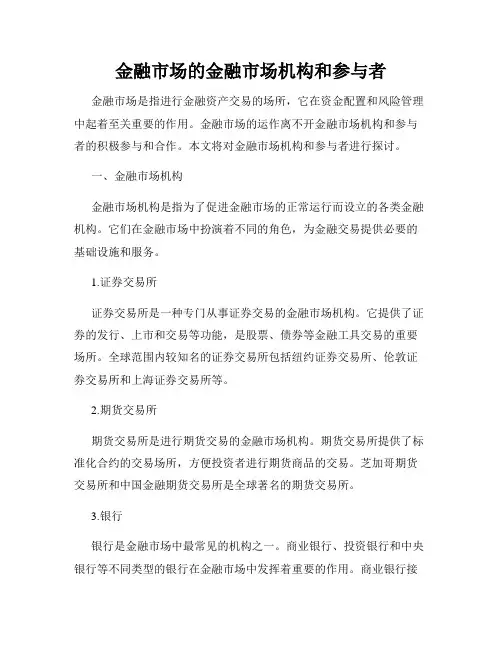
金融市场的金融市场机构和参与者金融市场是指进行金融资产交易的场所,它在资金配置和风险管理中起着至关重要的作用。
金融市场的运作离不开金融市场机构和参与者的积极参与和合作。
本文将对金融市场机构和参与者进行探讨。
一、金融市场机构金融市场机构是指为了促进金融市场的正常运行而设立的各类金融机构。
它们在金融市场中扮演着不同的角色,为金融交易提供必要的基础设施和服务。
1.证券交易所证券交易所是一种专门从事证券交易的金融市场机构。
它提供了证券的发行、上市和交易等功能,是股票、债券等金融工具交易的重要场所。
全球范围内较知名的证券交易所包括纽约证券交易所、伦敦证券交易所和上海证券交易所等。
2.期货交易所期货交易所是进行期货交易的金融市场机构。
期货交易所提供了标准化合约的交易场所,方便投资者进行期货商品的交易。
芝加哥期货交易所和中国金融期货交易所是全球著名的期货交易所。
3.银行银行是金融市场中最常见的机构之一。
商业银行、投资银行和中央银行等不同类型的银行在金融市场中发挥着重要的作用。
商业银行接受存款、发放贷款,为个人和企业提供金融服务;投资银行则专注于提供融资、并购、证券承销和交易等服务;中央银行负责货币发行和金融稳定。
4.保险公司保险公司是提供保险服务的金融机构。
它们接受投保人的保费,并承担一定风险的赔偿责任。
保险公司通过分散和转移风险的方式,为个人和企业提供了一定的保护和安全感。
二、金融市场参与者金融市场参与者是指在金融市场中进行交易和投资的个人和机构。
他们根据自身的需求和风险承受能力参与金融市场的交易活动。
1.个人投资者个人投资者是指以个人身份参与金融市场交易的投资者。
他们通过证券账户进行股票、债券、基金等金融工具的交易。
个人投资者通过参与金融市场来获取投资收益,实现资产增值。
2.机构投资者机构投资者是以机构身份参与金融市场交易的投资者。
这些机构包括养老基金、保险公司、投资基金、银行和大型企业等。
机构投资者通常拥有更丰富的资金和专业的研究能力,对金融市场的波动和机会有更深入的了解。
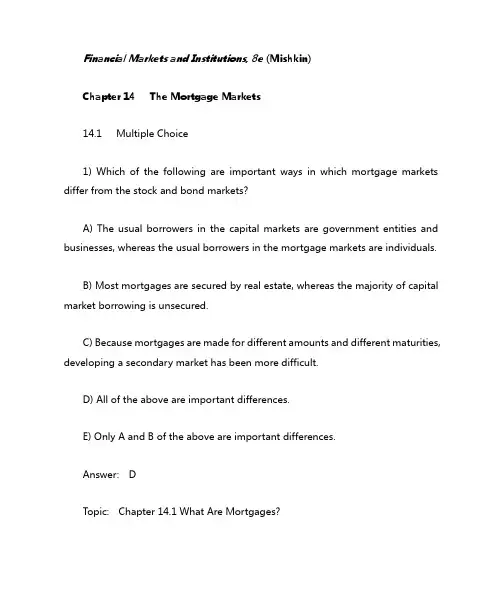
Financial Markets and Institutions, 8e (Mishkin)Chapter 14 The Mortgage Markets14.1 Multiple Choice1) Which of the following are important ways in which mortgage markets differ from the stock and bond markets?A) The usual borrowers in the capital markets are government entities and businesses, whereas the usual borrowers in the mortgage markets are individuals.B) Most mortgages are secured by real estate, whereas the majority of capital market borrowing is unsecured.C) Because mortgages are made for different amounts and different maturities, developing a secondary market has been more difficult.D) All of the above are important differences.E) Only A and B of the above are important differences.Answer: DTopic: Chapter 14.1 What Are Mortgages?Question Status: Previous Edition2) Which of the following are important ways in which mortgage markets differ from stock and bond markets?A) The usual borrowers in capital markets are government entities, whereas the usual borrowers in mortgage markets are small businesses.B) The usual borrowers in capital markets are government entities and large businesses, whereas the usual borrowers in mortgage markets are small businesses.C) The usual borrowers in capital markets are government entities and large businesses, whereas the usual borrowers in mortgage markets are small businesses and individuals.D) The usual borrowers in capital markets are businesses and government entities, whereas the usual borrowers in mortgage markets are individuals.Answer: DTopic: Chapter 14.1 What Are Mortgages?Question Status: Previous Edition3) Which of the following are true of mortgages?A) A mortgage is a long-term loan secured by real estate.B) A borrower pays off a mortgage in a combination of principal and interest payments that result in full payment of the debt by maturity.C) Over 80 percent of mortgage loans finance residential home purchases.D) All of the above are true of mortgages.E) Only A and B of the above are true of mortgages.Answer: DTopic: Chapter 14.1 What Are Mortgages?Question Status: Previous Edition4) Which of the following are true of mortgages?A) A mortgage is a long-term loan secured by real estate.B) Borrowers pay off mortgages over time in some combination of principal and interest payments that result in full payment of the debt by maturity.C) Less than 65 percent of mortgage loans finance residential home purchases.D) All of the above are true of mortgages.E) Only A and B of the above are true of mortgages.Answer: ETopic: Chapter 14.1 What Are Mortgages?Question Status: Previous Edition5) Which of the following are true of mortgage interest rates?A) Interest rates on mortgage loans are determined by three factors: current long-term market rates, the term of the mortgage, and the number of discount points paid.B) Mortgage interest rates tend to track along with Treasury bond rates.C) The interest rate on 15-year mortgages is lower than the rate on 30-year mortgages, all else the same.D) All of the above are true.E) Only A and B of the above are true.Answer: DTopic: Chapter 14.2 Characteristics of the Residential MortgageQuestion Status: Previous Edition6) Which of the following are true of mortgages?A) More than 80 percent of mortgage loans finance residential home purchases.B) The National Banking Act of 1863 rewarded banks that increased mortgage lending.C) Most mortgages during the 1920s and 1930s were balloon loans.D) All of the above are true.E) Only A and C of the above are true.Answer: ETopic: Chapter 14.1 What Are Mortgages?Question Status: Previous Edition7) Which of the following is true of mortgage interest rates?A) Longer-term mortgages have lower interest rates than shorter-term mortgages.B) Mortgage rates are lower than Treasury bond rates because of the tax deductibility of mortgage interest rates.C) In exchange for points, lenders reduce interest rates on mortgage loans.D) All of the above are true.E) Only A and B of the above are true.Answer: CTopic: Chapter 14.2 Characteristics of the Residential MortgageQuestion Status: Previous Edition8) Typically, discount points should not be paid if the borrower will pay off the loan in ________ years or less.A) 5B) 10C) 15D) 20Answer: ATopic: Chapter 14.2 Characteristics of the Residential MortgageQuestion Status: Previous Edition9) Which of the following is true of mortgage interest rates?A) Longer-term mortgages have higher interest rates than shorter-term mortgages.B) In exchange for points, lenders reduce interest rates on mortgage loans.C) Mortgage rates are lower than Treasury bond rates because of the tax deductibility of mortgage interest payments.D) All of the above are true.E) Only A and B of the above are true.Answer: ETopic: Chapter 14.2 Characteristics of the Residential MortgageQuestion Status: Previous Edition10) Which of the following reduces moral hazard for the mortgage borrower?A) CollateralB) Down paymentsC) Private mortgage insuranceD) Borrower qualificationsAnswer: BTopic: Chapter 14.2 Characteristics of the Residential MortgageQuestion Status: Previous Edition11) Which of the following protects the mortgage lender's right to sell property if the underlying loan defaults?A) A lienB) A down paymentC) Private mortgage insuranceD) Borrower qualificationE) AmortizationAnswer: ATopic: Chapter 14.2 Characteristics of the Residential MortgageQuestion Status: Previous Edition12) Which of the following is true of mortgage interest rates?A) Mortgage rates are closely tied to Treasury bond rates, but mortgage rates tend to stay below Treasury rates because mortgages are secured with collateral.B) Longer-term mortgages have higher interest rates than shorter-term mortgages.C) Interest rates are higher on mortgage loans on which lenders charge points.D) All of the above are true.E) Only A and B of the above are true.Answer: BTopic: Chapter 14.2 Characteristics of the Residential MortgageQuestion Status: Previous Edition13) During the early years of an amortizing mortgage loan, the lender appliesA) most of the monthly payment to the outstanding principal balance.B) all of the monthly payment to the outstanding principal balance.C) most of the monthly payment to interest on the loan.D) all of the monthly payment to interest on the loan.E) the monthly payment equally to interest on the loan and the outstanding principal balance.Answer: CTopic: Chapter 14.2 Characteristics of the Residential MortgageQuestion Status: Previous Edition14) During the last years of an amortizing mortgage loan, the lender appliesA) most of the monthly payment to the outstanding principal balance.B) all of the monthly payment to the outstanding principal balance.C) most of the monthly payment to interest on the loan.D) all of the monthly payment to interest on the loan.E) the monthly payment equally to interest on the loan and the outstanding principal balance.Answer: ATopic: Chapter 14.2 Characteristics of the Residential MortgageQuestion Status: Previous Edition15) During the last years of a balloon mortgage loan, the lender appliesA) most of the monthly payment to the outstanding principal balance.B) all of the monthly payment to the outstanding principal balance.C) most of the monthly payment to interest on the loan.D) all of the monthly payment to interest on the loan.E) the monthly payment equally to interest on the loan and the outstanding principal balance.Answer: DTopic: Chapter 14.2 Characteristics of the Residential MortgageQuestion Status: Previous Edition16) During the early years of a balloon mortgage loan, the lender appliesA) most of the monthly payment to the outstanding principal balance.B) all of the monthly payment to the outstanding principal balance.C) most of the monthly payment to interest on the loan.D) all of the monthly payment to interest on the loan.E) the monthly payment equally to interest on the loan and the outstanding principal balance.Answer: DTopic: Chapter 14.2 Characteristics of the Residential MortgageQuestion Status: Previous Edition17) A borrower who qualifies for an FHA or VA loan enjoys the advantage thatA) the mortgage payment is much lower.B) only a very low or zero down payment is required.C) the cost of private mortgage insurance is lower.D) the government holds the lien on the property.Answer: BTopic: Chapter 14.3 Types of MortgagesQuestion Status: Previous Edition18) (I) Conventional mortgages are originated by private lending institutions, and FHA or VA loans are originated by the government. (II) Conventional mortgages are insured by private companies, and FHA or VA loans are insured by the government.A) (I) is true, (II) false.B) (I) is false, (II) true.C) Both are true.D) Both are false.Answer: BTopic: Chapter 14.3 Types of MortgagesQuestion Status: Previous Edition19) Borrowers tend to prefer ________ to ________, whereas lenders prefer ________.A) fixed-rate loans; ARMs; fixed-rate loansB) ARMs; fixed-rate loans; fixed-rate loansC) fixed-rate loans; ARMs; ARMsD) ARMs; fixed-rate loans; ARMsAnswer: CTopic: Chapter 14.3 Types of MortgagesQuestion Status: Previous Edition20) (I) ARMs offer lower initial rates and the rate may fall during the life of the loan. (II) Conventional mortgages do not allow a borrower to take advantage of falling interest rates.A) (I) is true, (II) is false.B) (I) is false, (II) is true.C) Both are true.D) Both are false.Answer: ATopic: Chapter 14.3 Types of MortgagesQuestion Status: Previous Edition21) Growing-equity mortgages (GEMs)A) help the borrower pay off the loan in a shorter time.B) have such low payments in the first few years that the principal balance increases.C) offer borrowers payments that are initially lower than the payments on aconventional mortgage.D) do all of the above.E) do only A and B of the above.Answer: ATopic: Chapter 14.3 Types of MortgagesQuestion Status: Previous Edition22) A borrower with a 30-year loan can create a GEM byA) simply increasing the monthly payments beyond what is required and designating that the excess be applied entirely to the principal.B) converting his ARM into a conventional mortgage.C) converting his conventional mortgage into an ARM.D) converting his conventional mortgage into a GPM.Answer: ATopic: Chapter 14.3 Types of MortgagesQuestion Status: Previous Edition23) Which of the following are useful for home buyers who expect their income to rise in the future?A) GPMsB) RAMsC) GEMsD) Only A and B are useful.E) Only A and C are useful.Answer: ETopic: Chapter 14.3 Types of MortgagesQuestion Status: Previous Edition24) Which of the following are useful for home buyers who expect their income to fall in the future?A) GPMsB) RAMsC) GEMsD) Only A and B are useful.E) Only A and C are useful.Answer: BTopic: Chapter 14.3 Types of MortgagesQuestion Status: Previous Edition25) Retired people can live on the equity they have in their homes by using aA) GEM.B) GPM.C) SAM.D) RAM.Answer: DTopic: Chapter 14.3 Types of MortgagesQuestion Status: Previous Edition26) Second mortgages serve the following purposes:A) they give borrowers a way to use the equity they have in their homes as security for another loan.B) they allow borrowers to get a tax deduction on loans secured by their primary residence or vacation home.C) they allow borrowers to convert their conventional mortgages into GEMs.D) all of the above.E) only A and B of the above.Answer: ETopic: Chapter 14.3 Types of MortgagesQuestion Status: Previous Edition27) Which of the following is a disadvantage of a second mortgage compared to credit card debt?A) The loans are secured by the borrower's home.B) The borrower gives up the tax deduction on the primary mortgage.C) The borrower must pay points to get a second mortgage loan.D) The borrower will find it more difficult to qualify for a second mortgage loan.Answer: ATopic: Chapter 14.3 Types of MortgagesQuestion Status: Previous Edition28) The share of the mortgage market held by savings and loans isA) over 50 percent.B) approximately 40 percent.C) approximately 20 percent.D) less than 5 percent.Answer: DTopic: Chapter 14.4 Mortgage-Lending InstitutionsQuestion Status: Updated from Previous Edition29) The share of the mortgage market held by commercial banks is approximatelyA) 50 percent.B) 30 percent.C) 15 percent.D) 5 percent.Answer: BTopic: Chapter 14.4 Mortgage-Lending Institutions Question Status: Updated from Previous Edition30) A loan-servicing agent willA) package the loan for an investor.B) hold the loan in their investment portfolio.C) collect payments from the borrower.D) do both A and C of the above.E) do both B and C of the above.Answer: CTopic: Chapter 14.5 Loan ServicingQuestion Status: Previous Edition31) Distinct elements of a mortgage loan includeA) origination.B) investment.C) servicing.D) all of the above.E) only B and C of the above.Answer: DTopic: Chapter 14.6 Secondary Mortgage MarketQuestion Status: Previous Edition32) The Federal National Mortgage Association (Fannie Mae)A) was set up to buy mortgages from thrifts so that these institutions could make more loans.B) funds purchases of mortgages by selling bonds to the public.C) provides insurance for certain mortgage contracts.D) does all of the above.E) does only A and B of the above.Answer: ETopic: Chapter 14.6 Secondary Mortgage MarketQuestion Status: Previous Edition33) The Federal Housing Administration (FHA)A) was set up to buy mortgages from thrifts so that these institutions could make more loans.B) funds purchases of mortgages by selling bonds to the public.C) provides insurance for certain mortgage contracts.D) does all of the above.E) does only A and B of the above.Answer: CTopic: Chapter 14.3 Types of MortgagesQuestion Status: Previous Edition34) ________ issues participation certificates, and ________ provides federal insurance for participation certificates.A) Freddie Mac; Freddie MacB) Freddie Mac; Ginnie MaeC) Ginnie Mae; Freddie MacD) Ginnie Mae; Ginnie MaeE) Freddie Mac; no oneAnswer: ETopic: Chapter 14.8 What Is a Mortgage-Backed Security?Question Status: Previous Edition35) REMICs are most likeA) Freddie Mac pass-through securities.B) Ginnie Mae pass-through securities.C) participation certificates.D) collateralized mortgage obligations.Answer: DTopic: Chapter 14.8 What Is a Mortgage-Backed Security? Question Status: Previous Edition36) Ginnie MaeA) insures qualifying mortgages.B) insures pass-through certificates.C) insures collateralized mortgage obligations.D) does only A and B. of the above.E) does only B and C of the above.Answer: BTopic: Chapter 14.8 What Is a Mortgage-Backed Security? Question Status: Previous Edition37) Mortgage-backed securitiesA) have been growing in popularity in recent years as institutional investors look for attractive investment opportunities.B) are securities collateralized by a pool of mortgages.C) are securities collateralized by both insured and uninsured mortgages.D) are all of the above.E) are only A and B of the above.Answer: DTopic: Chapter 14.8 What Is a Mortgage-Backed Security?Question Status: Previous Edition38) The most common type of mortgage-backed security isA) the mortgage pass-through, a security that has the borrower's mortgage payments pass through the trustee before being disbursed to the investors.B) collateralized mortgage obligations, a security which reduces prepayment risk.C) the participation certificate, a security which passes the borrower's mortgage payments equally among all the owners of the certificates.D) the securitized mortgage, a security which increases the liquidity of otherwise illiquid mortgages.Answer: ATopic: Chapter 14.8 What Is a Mortgage-Backed Security?Question Status: Previous Edition39) The interest rate borrowers pay on their mortgages is determined byA) current long-term market rates.B) the term.C) the number of discount points.D) all of the above.Answer: DTopic: Chapter 14.2 Characteristics of the Residential MortgageQuestion Status: Previous Edition40) A loan for borrowers who do not qualify for loans at the usual market rate of interest because of a poor credit rating or because the loan is larger than justified by their income isA) a subprime mortgage.B) a securitized mortgage.C) an insured mortgage.D) a graduated-payment mortgage.Answer: ATopic: Chapter 14.8 What Is a Mortgage-Backed Security?Question Status: Previous Edition41) The percentage of the total loan paid back immediately when a mortgage loan is obtained, which lowers the annual interest rate on the debt, is calledA) discount points.B) loan terms.C) collateral.D) down payment.Answer: ATopic: Chapter 14.2 Characteristics of the Residential MortgageQuestion Status: Previous Edition42) Which of the following terms are found in mortgage loan contracts to protect the lender from financial loss?A) CollateralB) Down paymentC) Private mortgage insuranceD) All of the aboveAnswer: DTopic: Chapter 14.2 Characteristics of the Residential MortgageQuestion Status: Previous Edition43) What factors are used in determining a person's FICO score?A) Past payment historyB) Outstanding debtC) Length of credit historyD) All of the aboveAnswer: DTopic: Chapter 14.2 Characteristics of the Residential MortgageQuestion Status: Previous Edition44) Between 2000 and 2005, home prices increased an average of ________ per year.A) 2%B) 4%C) 8%D) 12%Answer: CTopic: Chapter 14.8 What Is a Mortgage-Backed Security?Question Status: New Question45) From 2000 to 2005, housing prices increased, on average, by over 40%. This run up in prices was caused byA) speculators.B) an increase in subprime loans, which increased demand for new and existing houses.C) both A and B.D) None of the above are correct.Answer: CTopic: Chapter 14.8 What Is a Mortgage-Backed Security?Question Status: Updated from Previous Edition14.2 True/False1) In 2012, mortgage loans to farms represented the largest proportion of mortgage lending in the U.S.Answer: FALSETopic: Chapter 14.1 What Are Mortgages?Question Status: New Question2) Down payments are designed to reduce the likelihood of default on mortgage loans.Answer: TRUETopic: Chapter 14.2 Characteristics of the Residential MortgageQuestion Status: Previous Edition3) Discount points (or simply points) are interest payments made at the beginning of a loan.Answer: TRUETopic: Chapter 14.2 Characteristics of the Residential MortgageQuestion Status: Previous Edition4) A point on a mortgage loan refers to one monthly payment of principal and interest.Answer: FALSETopic: Chapter 14.2 Characteristics of the Residential MortgageQuestion Status: Previous Edition5) Closing for a mortgage loan refers to the moment the loan is paid off.Answer: FALSETopic: Chapter 14.2 Characteristics of the Residential MortgageQuestion Status: Previous Edition6) Private mortgage insurance is a policy that guarantees to make up any discrepancy between the value of the property and the loan amount, should a default occur.Answer: TRUETopic: Chapter 14.2 Characteristics of the Residential MortgageQuestion Status: Previous Edition7) During the early years of a mortgage loan, the lender applies most of the payment to the principal on the loan.Answer: FALSETopic: Chapter 14.2 Characteristics of the Residential MortgageQuestion Status: Previous Edition8) One important advantage to a borrower who qualifies for an FHA or VA loan is the very low interest rate on the mortgage.Answer: FALSETopic: Chapter 14.3 Types of Mortgages9) Adjustable-rate mortgages generally have lower initial interest rates than fixed-rate mortgages.Answer: TRUETopic: Chapter 14.3 Types of MortgagesQuestion Status: Previous Edition10) Mortgage interest rates loosely track interest rates on three-month Treasury bills.Answer: FALSETopic: Chapter 14.3 Types of MortgagesQuestion Status: Previous Edition11) An advantage of a graduated-payment mortgage is that borrowers will qualify for a larger loan than if they requested a conventional mortgage.Answer: TRUETopic: Chapter 14.3 Types of Mortgages12) Nearly half the funds for mortgage lending comes from mortgage pools and trusts.Answer: FALSETopic: Chapter 14.4 Mortgage-Lending InstitutionsQuestion Status: Updated from Previous Edition13) Many institutions that make mortgage loans do not want to hold large portfolios of long-term securities, because it would subject them to unacceptably high interest-rate risk.Answer: TRUETopic: Chapter 14.4 Mortgage-Lending InstitutionsQuestion Status: Previous Edition14) A problem that initially hindered the marketability of mortgages in a secondary market was that they were not standardized.Answer: TRUETopic: Chapter 14.6 Secondary Mortgage MarketQuestion Status: Previous Edition15) Mortgage-backed securities have declined in popularity in recent years as institutional investors have sought higher returns in other markets.Answer: FALSETopic: Chapter 14.8 What Is a Mortgage-Backed Security?Question Status: Previous Edition16) Mortgage-backed securities are marketable securities collateralized by a pool of mortgages.Answer: TRUETopic: Chapter 14.8 What Is a Mortgage-Backed Security?Question Status: Previous Edition17) Fannie Mae and Freddie Mac together either own or insure the risk on nearly one-fourth of America's residential mortgages.Answer: FALSETopic: Chapter 14.4 Mortgage-Lending InstitutionsQuestion Status: Previous Edition18) A FICO score below 660 is considered good while a score above 720 is likely to cause problems in obtaining a loan.Answer: FALSETopic: Chapter 14.2 Characteristics of the Residential MortgageQuestion Status: Previous Edition19) Subprime loans are those made to borrowers who do not qualify for loans at the usual market rate of interest because of a poor credit rating or because the loan is larger than justified by their income.Answer: TRUETopic: Chapter 14.8 What Is a Mortgage-Backed Security?Question Status: Previous Edition14.3 Essay1) How has the modern mortgage market changed over recent years?Topic: Chapter 14.1 What Are Mortgages?Question Status: Previous Edition2) Explain the features of mortgage loans that are designed to reduce the likelihood of default.Topic: Chapter 14.2 Characteristics of the Residential MortgageQuestion Status: Previous Edition3) What are points? What is their purpose?Topic: Chapter 14.2 Characteristics of the Residential MortgageQuestion Status: Previous Edition4) How does an amortizing mortgage loan differ from a balloon mortgage loan?Topic: Chapter 14.2 Characteristics of the Residential MortgageQuestion Status: Previous Edition5) Evaluate the advantages and disadvantages, from both the lender's and borrower's perspectives, of fixed-rate and adjustable-rate mortgages.Topic: Chapter 14.3 Types of MortgagesQuestion Status: Previous Edition6) Why has the online lending market developed in recent years and what are the advantages and disadvantages of this development?Topic: Chapter 14.4 Mortgage-Lending InstitutionsQuestion Status: Previous Edition7) Why may Fannie Mae and Freddie Mac pose a threat to the health of the financial system?Topic: Chapter 14.8 What Is a Mortgage-Backed Security?Question Status: Previous Edition8) What are mortgage-backed securities, why were they developed, whattypes of mortgage-backed securities are there, and how do they work?Topic: Chapter 14.8 What Is a Mortgage-Backed Security?Question Status: Previous Edition9) What are the benefits and side effects of securitized mortgages?Topic: Chapter 14.7 Securitization of MortgagesQuestion Status: Previous Edition10) Discuss the pros and cons of a subprime market for residential mortgages in the U.S.Topic: Chapter 14.8 What Is a Mortgage-Backed Security?Question Status: New Question。


《金融市场与金融机构》米什金第七版课后习题答案
(请集中复习1-6、10-13、15章)
第一章为什么研究金融市场与金融机构
第二章金融体系概览
第三章利率的含义及其在定价中的作用
第四章为什么利率会变化
第五章利率的风险结构和期限结构如何影响利率
第六章金融市场是否有效
第十章货币政策传导:工具、目标战略和战术
第七版中的12题在第五六版中没有,此处的12-19题即为第七版的13-20题
第十一章货币市场
第十二章债券市场
第十三章股票市场
第十四章抵押贷款市场
第十五章外汇市场。
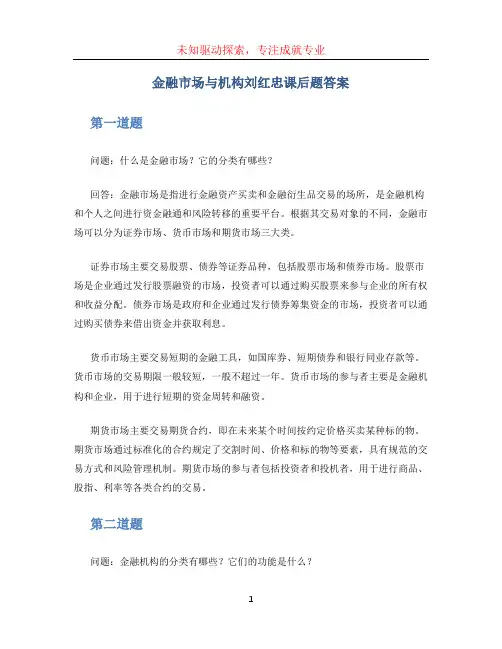
金融市场与机构刘红忠课后题答案第一道题问题:什么是金融市场?它的分类有哪些?回答:金融市场是指进行金融资产买卖和金融衍生品交易的场所,是金融机构和个人之间进行资金融通和风险转移的重要平台。
根据其交易对象的不同,金融市场可以分为证券市场、货币市场和期货市场三大类。
证券市场主要交易股票、债券等证券品种,包括股票市场和债券市场。
股票市场是企业通过发行股票融资的市场,投资者可以通过购买股票来参与企业的所有权和收益分配。
债券市场是政府和企业通过发行债券筹集资金的市场,投资者可以通过购买债券来借出资金并获取利息。
货币市场主要交易短期的金融工具,如国库券、短期债券和银行同业存款等。
货币市场的交易期限一般较短,一般不超过一年。
货币市场的参与者主要是金融机构和企业,用于进行短期的资金周转和融资。
期货市场主要交易期货合约,即在未来某个时间按约定价格买卖某种标的物。
期货市场通过标准化的合约规定了交割时间、价格和标的物等要素,具有规范的交易方式和风险管理机制。
期货市场的参与者包括投资者和投机者,用于进行商品、股指、利率等各类合约的交易。
第二道题问题:金融机构的分类有哪些?它们的功能是什么?回答:金融机构根据其业务性质和组织形式可以分为中央银行、商业银行、证券公司、保险公司和投资基金公司等。
中央银行是国家的货币和信用机构,负责制定和实施货币政策,维护金融市场的稳定。
中央银行的主要功能包括发行货币、管理外汇储备、进行利率调控、维护金融稳定等。
商业银行是主要从事存款储蓄、贷款和信用业务的金融机构。
商业银行的功能包括吸收存款、发放贷款、提供支付结算、进行信用调查、提供金融咨询等。
证券公司是从事证券经纪、承销和交易的金融机构。
证券公司的功能包括提供证券经纪服务、进行证券承销、参与股票和债券的交易等。
保险公司是提供保险服务的金融机构,主要从事风险管理和赔付业务。
保险公司的功能包括接受保险业务、收取保费、进行风险评估、赔付保险金等。
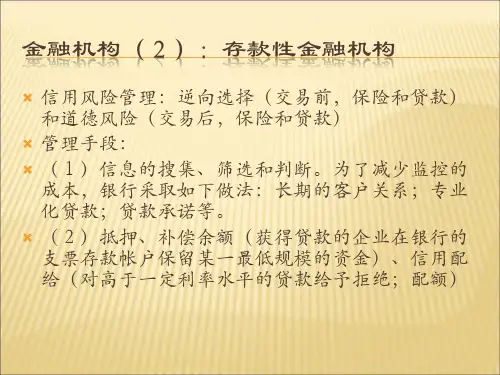
2019年证券从业资格考试《⾦融市场基础知识》⾼频考点汇总【⼗⼀】 证券从业考试备考已经过去许久,为了帮助考⽣能够更好的了解备考,下⾯由店铺⼩编为你精⼼准备了“2019年证券从业资格考试《⾦融市场基础知识》⾼频考点汇总【⼗⼀】”,持续关注本站将可以持续获取更多的考试资讯!2019年证券从业资格考试《⾦融市场基础知识》⾼频考点汇总【⼗⼀】 考点18:证券公司的主要业务 (⼀)证券经纪业务 在证券经纪业务中,经纪委托关系的建⽴表现为开户和委托两个环节。
(⼆)证券投资咨询业务 证券投资顾问业务和发布证券研究报告业务。
(三)与证券交易、证券投资活动有关的财务顾问业务 财务顾问业务,是指与证券交易、证券投资活动有关的咨询、建议、策划业务。
(四)证券承销与保荐业务 证券承销业务可以采取代销或者包销⽅式。
按照《证券法》的规定,向不特定对象发⾏的证券票⾯总值超过⼈⺠币5000万元的,应当由承销团承销,承销团由主承销商和参与承销的证券公司组成。
(五)证券⾃营业务 证券公司开展⾃营业务,或者设⽴⼦公司开展⾃营业务,都需要取得证券监管部⻔的业务许可,证券公司不得为从事⾃营业务的⼦公司提供融资或者担保。
(六)证券资产管理业务 证券公司从事资产管理业务,应当获得证券监管部⻔批准的客户资产管理业务资格。
投资主办⼈不得少于5⼈,且须具有3年以上从业经历,并通过中国证券业协会的注册登记。
证券公司依法可以从事为单⼀客户办理定向资产管理业务、为多个客户办理集合资产管理业务、为客户办理特定⺫的的专项资产管理业务。
(七)融资融券业务 融资融券交易分为融资交易和融券交易两类。
证券公司开展融资融券业务,必须经中国证监会批准。
证券公司向客户融资融券,应当向客户收取⼀定⽐例的保证⾦,保证⾦可以证券充抵。
(⼋)证券公司中间介绍业务 证券公司中间介绍业务:是指证券公司接受期货经纪商的委托,为期货经纪商介绍客户参与期货交易并提供其他相关服务的业务活动。
2021年金融市场基础知识单选题与答案解析11一、单选题(共60题)1.政策性银行发行金融债券应当向()报送发行申请。
A:国家开发银行B:中国进出口银行C:中国人民银行D:中国农业发展银行【答案】:C【解析】:根据《全国银行间债券市场金融债券发行管理办法》,政策性银行发行金融债券,应按年向中国人民银行报送金融债券发行申请。
2.根据保险业务属性和风险特征,保险公司业务范围分为基础类业务和扩展类业务,以下属于财产保险公司的基础类业务的是()。
A:责任保险B:农业保险C:信用证保险D:分红型保险【答案】:A【解析】:本题考查保险的分类。
财产保险公司的基础类业务包括以下五项:①机动车保险,包括机动车交通事故责任强制保险和机动车商业保险;②企业/家庭财产保险及工程保险(特殊风险保险除外);③责任保险;④船舶/货运保险;⑤短期健康/意外伤害保险。
3.根据证券化的基础资产不同,可以将资产证券化分为()债券组合证券化等类别。
Ⅰ.不动产证券化Ⅱ.应收账款证券化Ⅲ.信贷资产证券化Ⅳ.未来收益证券化A:Ⅱ、Ⅲ、ⅣB:Ⅰ、Ⅱ、ⅢC:Ⅰ、Ⅱ、Ⅲ、ⅣD:Ⅰ、Ⅱ、Ⅳ【答案】:C【解析】:根据基础资产分类。
根据证券化的基础资产不同,可以将资产证券化分为不动产证券化、应收账款证券化、信贷资产证券化、未来收益证券化(如高速公路收费)、债券组合证券化等类别。
4.沪深300指数所选择的公司一般满足下列()条件。
①经营状况良好②股票价格无明显异常波动③财务报告无重大问题④无明显市场操纵A:①②③④B:①②④C:②③④D:①③④【答案】:A【解析】:上述四项皆为沪深300指数选择样本股票所考虑的条件。
沪深300指数样本按照以下方法选择经营状况良好、无违法违规事件、财务报告无重大问题、股票价格无明显异常波动或市场操纵的公司:计算样本空间内股票最近一年(新股为上市第四个交易日以来)的A股日均成交金额与A股日均总市值;对样本空间股票在最近一年的A 股日均成交金额由高到低排名,剔除排名后50%股票;对剩余股票按照最近一年A股日均总市值由高到低排名,选取前300名股票作为指数样本。
理解金融市场的机构和参与者的角色金融市场是经济活动中至关重要的组成部分,它提供了各种金融工具和服务,扮演着促进资源配置和风险管理的关键角色。
为了更好地理解金融市场的运作机制,我们需要了解金融市场的机构和参与者的角色。
一、金融市场的机构角色1. 金融交易所:金融交易所是金融市场的核心机构之一。
它为各种金融产品(如股票、债券、商品期货等)提供一个规范的交易场所和交易规则,促进市场的流动性和透明度。
同时,交易所还提供市场信息、价格发现和风险管理等服务。
2. 银行体系:银行体系是金融市场的另一个重要机构。
银行作为金融中介机构,承担着吸收存款、发放贷款、支付结算等职能,为企业和个人提供融资和储蓄渠道。
此外,银行还通过资金调度和风险管理等方式,提供金融市场的稳定运行。
3. 证券公司:证券公司是金融市场的中介机构之一,主要提供证券交易、承销与发行等服务。
证券公司通过发行股票、债券等证券产品,将企业和个人的资金与资本市场连接起来,促进企业融资和资金募集。
4. 保险公司:保险公司是金融市场的风险管理机构。
它接受保险费用,为客户提供风险保障和赔付服务。
保险公司通过承担风险,为经济主体提供保险保障,提高了社会经济的稳定性。
二、金融市场的参与者角色1. 投资者:投资者是金融市场的重要参与者之一,包括个人投资者和机构投资者。
个人投资者通常是通过购买证券(如股票、债券、基金等)或参与投资计划来参与金融市场。
机构投资者(如养老基金、保险公司等)则通过管理资金来进行投资,并参与金融市场的交易和运作。
2. 借款人:借款人是金融市场的重要参与者之一,包括个人借款人和企业借款人。
借款人通过向金融机构(如银行、债券市场等)申请贷款,获得所需的资金支持。
借款人将资金用于经营、投资或个人消费等目的。
3. 发行人:发行人是指在金融市场发行金融产品(如股票、债券等)的实体。
发行人可以是政府、企业或其他机构。
通过发行证券,发行人可以获得必要的资金来满足其融资需求。
Chapter 11The Stock MarketMultiple Choice Questions1. (I) A share of common stock in a firm represents an ownership interest in that firm. (II) A share ofpreferred stock is as much like a bond as it is like common stock.(a) (I) is true, (II) false.(b) (I) is false, (II) true.(c) Both are true.(d) Both are false. Answer: C2. Preferred stockholders hold a claim on assets that has priority over the claims of(a) both common stockholders and bondholders.(b) neither common stockholders nor bondholders.(c) common stockholders, but after that of bondholders.(d) bondholders, but after that of common stockholders. Answer: C3. (I) Preferred stockholders hold a claim on assets that has priority over the claims of commonstockholders, but after that of bondholders. (II) Firms issue preferred stock in far greater amounts than common stock.(a) (I) is true, (II) false.(b) (I) is false, (II) true.(c) Both are true.(d) Both are false.Answer: A4. (I) Preferred stockholders hold a claim on assets that has priority over the claims of commonstockholders. (II) Bondholders hold a claim on assets that has priority over the claims of preferred stockholders.(a) (I) is true, (II) false.(b) (I) is false, (II) true.(c) Both are true.(d) Both are false.Answer: C5. (I) Firms issue common stock in far greater amounts than preferred stock. (II) The total volume of stock issued ismuch less than the volume of bonds issued.(a)(I) is true, (II) false. (b)(I) is false, (II) true. (c)Both are true. (d) Both are false.Answer: C6. The riskiest capital market security is(a) preferred stock.(b) common stock.(c) corporate bonds.(d) Treasury bonds.Answer: B7. Organized exchanges account for about stock sharestraded.(a)30 (b)45 (c)60 (d) 70 Answer: D8. Organized exchanges account for about stocks traded.(a) 60(b) 70(c) 80(d) 90Answer: B9. (I) The largest of the organized stock exchanges in the United States is the New York StockExchange. (II) To be listed on the NYSE, a firm must have a minimum of $100 million dollars in market value or $10 million in revenues.(a) (I) is true, (II) false.(b) (I) is false, (II) true.(c) Both are true.(d) Both are false.Answer: A10. To list on the NYSE, a firm must(a) have earnings of at least $100 million for each of the last three years.(b) have at least $500 million of market value and $100 million of revenue.(c) have a total of $100 million in market value of publicly traded shares.(d) meet all of the above requirements.(e) meet (a) and (b) of the above requirements.Answer: E欢迎下载 136percent of the total dollar volume of domesticpercent of the total dollar volume of domestic11. Securities not listed on one of the exchanges trade in the over-the-counter market. In this exchange, dealers “makea market ” by(a) buying stocks for inventory when investors want to sell.(b) selling stocks from inventory when investors want to buy.(c) doing both of the above.(d) doing neither of the above. Answer: C12. The most active stock exchange in the world is the(a) Nikkei Stock Exchange.(b) London Stock Exchange.(c) Shanghai Stock Exchange.(d) New York Stock Exchange. Answer: A13. Which of the following statements about trading operations in an organized exchange are correct?(a) Floor traders all deal in a wide variety of stocks.(b) In most trades, specialists match buy and sell orders.(c) In most trades, specialists buy for or sell from their own inventories.(d) The SuperDOT system is used to expedite large trades of over 100,000 shares. Answer: B14. Which of the following is not an advantage of Electronic Communications Networks (ECNs)?(a) All unfilled orders are available for review by ECN traders.(b) Transactions costs are lower for ECN trades.(c) Trades are made and confirmed faster.(d) ECNs work well for thinly traded stocks. Answer: D15. Which of the following statements is false regarding Electronic Communications Networks (ECNs)?(a) Archipelago and Instinet are two examples of ECNs.(b) Competition from ECNs has forced NASDAQ to cut its fees.(c) Traders benefit from lower trading costs and faster service.(d) ECNs allow institutional investors, but not individuals, to trade after hours. Answer: D16. A basic principle of finance is that the value of any investment is(a) the present value of all future net cash flows generated by the investment.(b) the undiscounted sum of all future net cash flows generated by the investment.(c) unrelated to the future net cash flows generated by the investment.(d) unrelated to the degree of risk associated with the future net cash flows generated by the investment.Answer: A17. A stock currently sells for $25 per share and pays $0.24 per year in dividends. What is an investor valuation of thisstock if she expects it to be selling for $30 in one year and requires 15 percent return on equity investments?(a) $30.24(b) $26.30(c) $26.09(d) $27.74Answer: B18. A stock currently sells for $30 per share and pays $1.00 per year in dividends. What is an investor valuation of thisstock if he expects it to be selling for $37 in one year and requires 12 percent return on equity investments?(a) $38(b) $33.50(c) $34.50(d) $33.93Answer: D19. In the one-period valuation model, a stock 's value will be higher(a) the higher is its expected future price.(b) the lower is its dividend.(c) the higher is the required return on investments in equity.(d) all of the above.Answer: A20. In the one-period valuation model, a stock 's value falls if the ___________ rises.(a) dividend(b) expected future price(c) required return on equity(d) current priceAnswer: C21. In the generalized dividend valuation model a stock ' s value depend only on(a) its future dividend payments and its future price.(b) its future dividend payments and the required return on equity.(c) its future price and the required return on investments on equity.(d) its future dividend payments.Answer: B22. Which of the following is not an element of the Gordon growth model of stock valuation?(a) the stock 's most recent dividend paid.(b) the expected constant growth rate of dividends.(c) the required return on investments in equity.(d) the stock 's expected future price.Answer: D23. According to the Gordon growth model, what is an investor 's valuation of a stock whose currdividend is $1.00 per year if dividends are expected to grow at a constant rate of 10 percent over a long period of time and the investor 's required return is 11 percent?(a) $110(b) $100(c) $11(d) $10(e) $5.24Answer: A24. According to the Gordon growth model, wha t is an investor 's valuation of a stock whose currentdividend is $1.00 per year if dividends are expected to grow at a constant rate of 10 percent over a long period of time and the investor 's required return is 15 percent?(a)$20 (b)$11 (c)$22 (d)$7.33 (e) $4.40Answer: C28. Suppose the average industry PE ratio for auto parts retailers is 20. What is the current price of Auto Zone stock ifthe retailer ' s earnings per share are projected to be $1.85?(a) $21.85(b) $37(c) $10.81(d) $9.25 Answer: B29.Which of the following is true regarding the Gordon growth model?(a) Dividends are assumed to grow at a constant rate forever.(b) The dividend growth rate is assumed to be greater than the required return on equity.25. Holding other things constant, a stock(a) 15 percent(b) 10 percent(c) 5 percent(d) 2 percentAnswer: As value will be highest if its dividend growth rate is 26. Holding other things constant, a stock(a) $2.00(b) $5.00(c) $0.50(d) $1.00Answer: B27. Holding other things constant, a stockinvestments in equity is(a) 20 percent(b) 15 percent(c) 10 percent(d) 5 percentAnswer: Ds valueiwf iitlsl bmeohsitgrheecsetnt dividend is s value will be highest if the investor 's r(c) Both (a) and (b).(d) Neither (a) nor (b). Answer: A30. The PE ratio approach to valuing stock is especially useful for valuing(a) privately held firms.(b) firms that don 't pay dividends.(c) both (a) and (b).(d) neither (a) nor (b). Answer: C31. The PE ratio approach to valuing stock is especially useful for valuing(a) publicly held corporations.(b) firms that regularly pay dividends.(c) both (a) and (b).(d) neither (a) nor (b). Answer: D32. A weakness of the PE approach to valuing stock is that it is(a) difficult to estima te the constant growth rate of a firm ' s dividends.(b) difficult to estimate the required return on equity.(c) difficult to predict how much a firm will pay in dividends.(d) based on industry averages rather than firm-specific factors. Answer: D33. A firm is expected to pay a dividend of $1.00 next year and the dividend is expected to grow at a constant rate of 4percent over time. Some investors have required returns on investments in equity of 12 percent, some 10 percent, and some 8 percent. The marketprice of this firm 's stock will beslightly above(a) $25(b) $18(c) $16.67(d) $12.50Answer: C34. (I) The market price of a security at a given time is the highest value any investor puts on the security. (II)Superior information about a security increases its value by reducing its risk.(a) (I) is true, (II) is false.(b) (I) is false, (II) is true.(c) Both are true.(d) Both are false. Answer: B35. The main cause of fluctuations in stock prices is changes in(a) tax laws.(b) errors in technical stock analysis.(c) daily trading volume in stock markets.(d) information available to investors.(e) total household wealth in the economy. Answer: D36. Stock values computed by valuation models may differ from actual market prices because it is difficult to(a) estimate future dividend growth rates.(b) estimate the risk of a stock.(c) forecast a stock 's future dividends.(d) all of the above are true. Answer: D37. The 2001 terrorist attacks and the Enron financial scandal caused anticipated dividend growth to ___ ,investors ' required return on equity to ________________________ , and stock prices to _________(a) decreases; increase; decrease(b) decrease; increase; increase(c) increase; decrease; decrease(d) increase; decrease; increaseAnswer: A38. Which of the following is not an objective of the Securities and Exchange Commission?(a) maintain integrity of the securities markets(b) advise investors about which particular stocks are good buys(c) require firms to provide specific information to investors(d) regulate major participants in securities markets Answer: BTrue/False1. More stock trading in the U.S. occurs in over-the-counter markets rather than on organizedexchanges. Answer: FALSE2. In over-the-counter markets, dealers increases the liquidity of thinly traded securities.Answer: TRUE3. Electronic Communications Networks apply technology to make organized exchanges moreefficient and speedy.Answer: FALSE4. All stocks pay dividends, as that is the only way an investor can profit from holding stock.Answer: FALSE5. Common stock is the riskiest corporate security, followed by preferred stock and then bonds. Answer: TRUE6. The Enron financial scandal increased uncertainty about the quality of accounting information andas a result increased required return on investment in stocks. Answer: TRUE7. The Dow Jones Industrial Average is the broadest and best indicator of the stock marketday-to-day performance. Answer: FALSE8. The Securities and Exchange Commission requires firms to submit various documents to increasethe flow of information to investors but does not verify the accuracy of that information. Answer: TRUE9. About half of new equity issues are preferred stock.Answer: FALSE10. A stock 's market value will be higher the highesriits expected dividend stream. Answer: TRUE11. The Gordon growth model assumes that a stock ' s dividend grows at a constant rate forever.Answer: TRUE12. A stock 's market value will be higher the higher is the investor 's required rate of return.Answer: FALSEEssay1. How do corporate stocks differ from bonds?2. How do common stocks differ from preferred stock?3. How do over-the-counter markets differ from organized exchanges?4. What is the role of specialists on a stock exchange?5. What are the advantages and disadvantages of Electronic Communications Networks (ECNs) fortrading stocks?6. What is the role of the required return on equity investments in stock valuation models?7. Using the Gordon growth model, explain why the 2001 terorist attacks and the Enron financialscandal caused stock prices to decline.8. What are American Depository Receipts (ADRs)?9. What are the objectives of the Securities and Exchange Commission?。